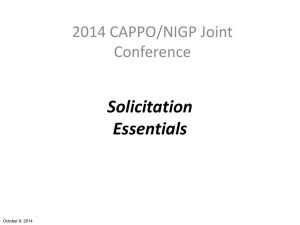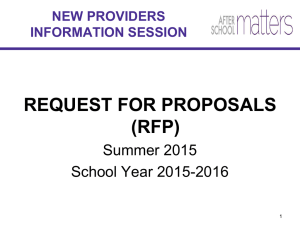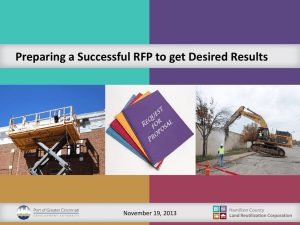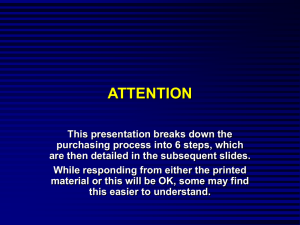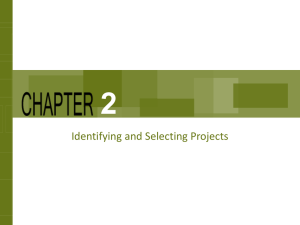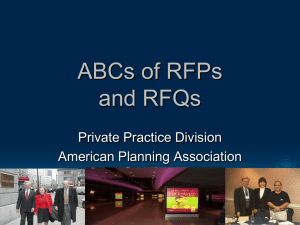Request for Proposal - University at Albany
advertisement
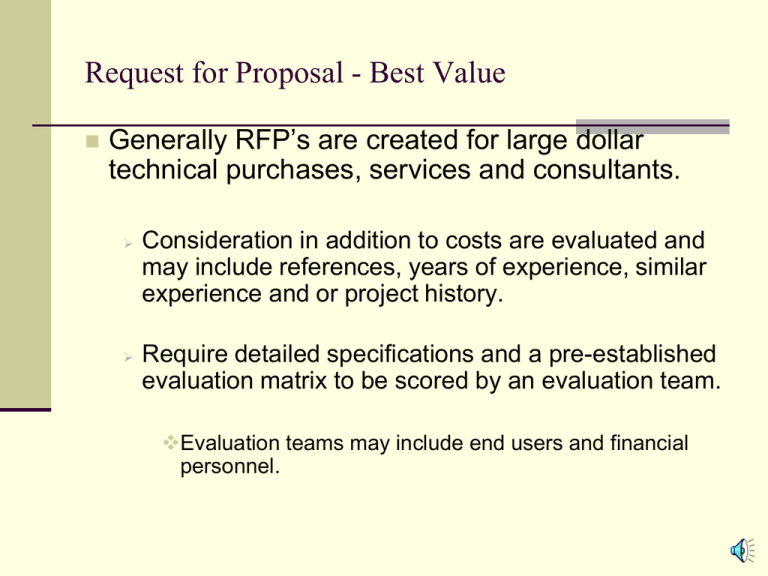
Request for Proposal - Best Value Generally RFP’s are created for large dollar technical purchases, services and consultants. Consideration in addition to costs are evaluated and may include references, years of experience, similar experience and or project history. Require detailed specifications and a pre-established evaluation matrix to be scored by an evaluation team. Evaluation teams may include end users and financial personnel. Drafting an RFP Drafting RFP’s Develop the scoring matrix with the RFP Mandatory items-Pass/Fail Ex. Vendor Minimum Qualifications Scoring criteria-weighted % Licenses Regulatory scoring Equipment list Experience Technical evaluation References Cost The RFP document usually includes Information on the University and Department’s mission. A brief description of the project. A list of mandatory requirements for all vendor’s to meet. Technical scoring criteria and informational response section Drafting RFP’s (Cont’d) The matrix and RFP are drafted together to ensure that the answers scored in the matrix appear as questions in the RFP. Mandatory requirements are evaluated on a pass/fail basis but are not included in the scoring criteria. Proposals meeting mandatory requirements are scored against the matrix. Cost should be at least 20% of the total scoring criteria depending on the value to be placed on the technical portion. Software purchases may have lower weighted cost (i.e., 25%) while services may have a higher weighted cost (i.e., 60%). Drafting RFP’s (Cont’d) Objective questions include the following: Years of experience Number of similar projects performed Number of qualified staff assigned to the project Subjective questions should be avoided because the responses are subject to interpretation. Benchmarks/standards should be used to compare bidder responses. References should be reviewed via a questionnaire. Questions should prompt responses from the reference such as yes or no or good, fair, poor. RFP-Evaluation Process Forming and Instructing the Review Team All members of the RFP evaluation team must participate in the scoring of all the proposals. Multiple levels of scoring Mandatory items Technical Specifications References Oral Presentations Additional Points or Rescoring Financial Statements; may require assistance from an individual with the ability and expertise to evaluate the document. Cost RFP-Evaluation Process (Cont’d) Most cost awards are based on a formula. For example, the lowest bidder receives the highest rating and the next lowest bidders get a portion of the points awarded. The base score as outlined in the RFP can be set to limit the number of bidders receiving invitations for oral interviews/presentations. The scoring used for the oral interviews must be outlined in the RFP. The scoring process may allow for the review team to ask for written clarification. Written clarification required from a bidder must have a due date and time. RFP-Evaluation Process (Cont’d) Multiple awards can be made from one RFP: The awarding of work must be outlined clearly in the RFP. There is no guarantee of the amount of work to be assigned, but the contract is to be for the actual amount of work assigned during the term. Cost is the critical factor in the review by OSC and must be clear to the auditor. For a new type of RFP or Bid, the Purchasing Office will often seek out information from other SUNY’s, Agencies or pass a draft of the procurement to OSC for comment before it goes out to the vendor community. Vendors must be notified in writing of rejected proposals and be given an opportunity for debriefing. Time Line Based on Final Draft RFP & Scoring Matrix Contract Reporter Advertisement 3 Week Min. Scoring of RFP’s Approximately 2-3 Weeks Contract Development and Signature 3 Weeks NYS Attorney General Approval 2 Weeks NYS Comptroller Approval 4-6 Week Min.

